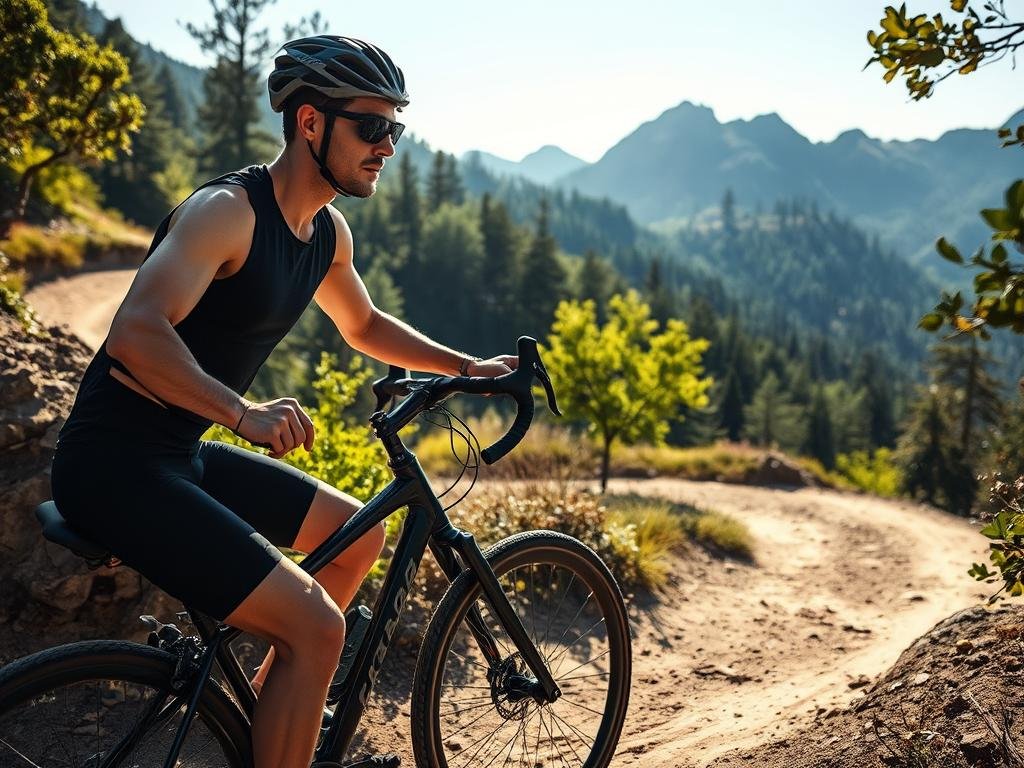Structured training is essential for excelling in ultra-endurance events. These races demand not only physical strength but also mental resilience to tackle challenging terrains and unpredictable conditions. A well-organized plan helps athletes build the necessary stamina, technical skills, and pacing strategies to perform at their best.
One proven method is the 5-pillar approach, which includes endurance, speed, technical skills, hike-a-bike preparation, and route research. Each pillar plays a vital role in preparing riders for the rigors of long-distance races. For example, endurance training builds aerobic capacity, while technical skills ensure safe navigation through diverse landscapes.
Jenny Graham’s record-breaking performance in the Arizona Trail 750 highlights the effectiveness of this approach. Her meticulous preparation, including route research and hike-a-bike training, allowed her to complete the 750-mile route in just 14 days.
Balancing long rides with intensity work is another key factor. Long rides build foundational endurance, while interval training improves anaerobic power and recovery. This combination ensures athletes can maintain steady efforts and respond to sudden challenges efficiently.
Monitoring key metrics like VO2Max, pacing strategies, and fatigue management is also crucial. These metrics help athletes optimize performance and reduce the risk of overtraining or injury.
Table of Contents
Key Takeaways
- Structured training is vital for ultra-endurance events.
- The 5-pillar approach includes endurance, speed, technical skills, hike-a-bike prep, and route research.
- Balancing long rides with intensity work enhances efficiency.
- Key metrics like VO2Max and pacing strategies are critical for success.
- Jenny Graham’s achievements demonstrate the effectiveness of comprehensive training.
Mountain Biking Workouts for Endurance: The Foundation
Building endurance is the cornerstone of success in technical terrain. Riders who develop a strong aerobic base can tackle rocky descents and sustained climbs without losing energy. This ability is critical, as technical terrain increases energy expenditure by 30% compared to smooth trails.

Why Endurance Matters for Technical Terrain
Endurance training enhances the body’s ability to utilize fat as a primary energy source, conserving glycogen stores. This adaptation is particularly beneficial during prolonged efforts, such as sustained climbs, where maintaining a steady energy output is crucial. By improving aerobic capacity, endurance training helps cyclists manage energy more efficiently, reducing the likelihood of “energy leaks” during challenging terrains.
Heart rate zones play a key role in endurance training. Zone 2, the Endurance Zone, ranges from 82% to 88% of Functional Threshold Heart Rate (FTHR) and is ideal for longer rides, including sustained climbs. Training in this zone enhances aerobic capacity, enabling cyclists to maintain a steady effort during prolonged climbs.
Balancing Long Rides with Speed Work
The 80/20 rule is a proven strategy for endurance training. It suggests dedicating 80% of training volume to low-intensity efforts and 20% to high-intensity efforts. This approach builds a strong aerobic base while incorporating sufficient intensity to improve performance. Balancing easy and structured intensity sessions helps cyclists enhance endurance and power without overtraining.
Power meters are valuable tools for monitoring performance across different gradients. By analyzing power data, cyclists can adjust their effort to maintain consistent output during climbs and descents. This data-driven approach optimizes energy expenditure and pacing strategies, leading to improved climbing efficiency and overall performance.
| Training Zone | Heart Rate Range | Purpose |
|---|---|---|
| Zone 1 (Recovery) | 65% – 81% of FTHR | Active recovery |
| Zone 2 (Endurance) | 82% – 88% of FTHR | Long rides, sustained climbs |
For those looking to boost torque, single-speed training is an effective option. Athletes who incorporate single-speed rides have reported improvements in torque output by up to 15%. This adaptation is beneficial for climbing, as it allows cyclists to generate more power at lower cadences.
To learn more about structuring your endurance training, check out this comprehensive guide.
Build Endurance with Progressive Long Rides
Progressive long rides are a game-changer for building stamina. They help you adapt to longer distances while minimizing the risk of overtraining. By gradually increasing your ride time, you can enhance your endurance and power effectively.

How to Structure Your Longest Sessions
Start by increasing your weekly distance by 10%. This approach prevents overtraining and ensures steady progress. For example, if you ride 50 miles one week, aim for 55 miles the next. This gradual increase allows your body to adapt without strain.
Consider fasted morning rides to boost fat adaptation. Training without food improves your body’s ability to use fat as an energy source. This is especially useful for multi-hour efforts where conserving energy is key.
Pacing Strategies for Multi-Hour Efforts
Maintain a “sweet spot” pace at 85-90% of your Functional Threshold Power (FTP). This intensity improves endurance and power without excessive fatigue. It’s ideal for sustained climbs and long rides.
Use tools like TrainingPeaks to track Time to Exhaustion (TTE). This metric helps you understand how long you can sustain a specific power output. Regularly reviewing TTE data can optimize your training and performance.
End your ride with a 30-minute race-pace effort. This simulates race conditions and improves your ability to maintain high intensity when fatigued. For example, after a 4-hour ride, push yourself to finish strong.
- Increase weekly distance by 10% to avoid overtraining.
- Try fasted morning rides to enhance fat adaptation.
- Maintain a sweet spot pace for sustained climbs.
- Track TTE metrics to optimize performance.
- Finish long rides with a race-pace effort.
Incorporate Interval Training for Speed and Stamina
Interval training is a powerful tool to enhance both speed and stamina. By alternating between high and low intensity, these sessions push your limits while allowing for recovery. This method is especially effective for improving performance in demanding conditions.

Tempo Workouts: Sustained Threshold Efforts
Tempo workouts focus on sustained threshold efforts, typically at 88-94% of your Functional Threshold Power (FTP). These sessions build endurance and teach your body to maintain a steady pace over long distances.
For example, a 3×20-minute tempo workout can significantly improve your ability to handle prolonged climbs. The key is to stay consistent and avoid pushing too hard, which can lead to burnout.
VO2Max Intervals: Boosting Aerobic Capacity
VO2Max intervals are short, high-intensity bursts designed to improve aerobic capacity. A 2x10x1-minute protocol, for instance, can increase FTP by 8% in just six weeks.
These efforts typically range from 106-120% of FTP. They challenge your cardiovascular system, making it more efficient at delivering oxygen to your muscles.
Polarized training, which combines low-intensity rides with high-intensity intervals, is particularly beneficial for technical riders. It maximizes performance gains while minimizing fatigue.
Case Study: Melanie McQuaid’s 15-second max-force intervals helped her dominate technical courses. This approach improved her power output and recovery time.
Warning: Limit high-intensity sessions to twice a week to prevent burnout and overtraining. Balance is key to long-term success.
Strength Training for Mountain Biking Efficiency
Strength training is a critical component for improving efficiency in demanding activities. It enhances muscle power and stability, which are essential for sustained performance. Incorporating targeted exercises into your routine can lead to significant gains in both force and endurance.

Gym Exercises to Boost On-Bike Performance
Deadlifts are a cornerstone of effective strength training. Performing them at 70% of your one-repetition maximum (1RM) strengthens the posterior chain, including the hamstrings, glutes, and lower back. This development improves overall power output and reduces injury risk.
Bulgarian split squats are another valuable exercise. They enhance unilateral stability by isolating each leg, correcting muscle imbalances, and improving balance. This exercise targets the quadriceps, hamstrings, and glutes, contributing to better lower body strength and coordination.
Single-Speed Rides for Enhanced Leg Strength
Incorporating single-speed trail rides into your routine can significantly boost leg strength. These rides, ideally under two hours, improve cardiovascular endurance and muscular strength. Riding on varied terrains challenges the body, leading to increased efficiency and power output.
Achieving a power-to-weight ratio of 5 watts per kilogram (W/kg) on a 5% grade is a strong indicator of cycling performance. This metric reflects your ability to generate power relative to body weight, which is crucial for climbing efficiency.
Pro Tip: Avoid heavy lifting within 72 hours of race day to ensure optimal performance. Intense strength training close to a race can lead to muscle fatigue and decreased endurance. Allow sufficient recovery time for the best results.
Master Technical Skills to Conserve Energy
Mastering technical skills can significantly reduce energy expenditure during rides. Riders with advanced abilities save up to 200kcal/hour compared to novices. This efficiency is crucial for maintaining stamina on challenging terrains.

Skills courses have been shown to reduce hike-a-bike time by 40%. This improvement allows riders to focus on endurance rather than wasting energy on dismounts and remounts. Here are some actionable tips to enhance your technical proficiency:
- Drill bunny hops over 6″ obstacles to clear roots efficiently.
- Practice track stands to minimize dismounts on switchbacks.
- Analyze GoPro footage to identify line-choice inefficiencies.
- Commit to 20-minute daily pump track sessions for skill refinement.
- Explore Global Mountain Bike Network tutorials for expert guidance.
Technical riders not only conserve energy but also navigate diverse terrains with ease. This ability is essential for maintaining a steady pace and avoiding unnecessary fatigue.
| Rider Type | Energy Expenditure (kcal/hour) | Hike-a-Bike Time Reduction |
|---|---|---|
| Novice | High | 0% |
| Technical Rider | Low (200kcal saved) | 40% |
By investing time in skill development, you can optimize your energy usage and improve overall performance. Focus on mastering these techniques to tackle any terrain with confidence.
Optimize Nutrition and Hydration for Long Rides
Proper fueling and hydration are key to sustaining performance during extended efforts. Without the right balance of nutrients and fluids, your energy levels can plummet, leaving you unable to maintain pace or recover effectively.
Pre-Ride Fueling Strategies
Start your day with a meal rich in carbohydrates, which are the primary energy source for your muscles and brain. Aim for 2 to 4 grams of carbs per kilogram of body weight, depending on your tolerance. A 3:1 carb-to-protein ratio is ideal for pre-ride meals, as it helps top off glycogen stores and delays fatigue.
Choose familiar foods that are low in fat and easy to digest. Avoid experimenting with new foods on race day to prevent stomach discomfort. Timing is also crucial—consume your meal 2 to 4 hours before your ride for optimal digestion.
Electrolyte Management During Events
Hydration goes beyond just water. Replacing lost electrolytes is essential to maintain muscle function and prevent cramping. Sodium loss rates can range from 800 to 1,500mg per liter of sweat, so replenishing sodium is critical.
Commercial options like UCAN Hydrate provide a zero-sugar, zero-calorie solution with essential electrolytes. Alternatively, DIY mixes using maple syrup and sea salt can be equally effective. Monitor your fluid intake, limiting it to 750ml per hour unless conditions are extreme.
For quick energy boosts, Medjool dates are a compact option, packing 66 calories each. Keep these on hand for emergencies when you need a rapid calorie refill.
- Follow a 3:1 carb-to-protein ratio for pre-ride meals.
- Choose familiar, low-fat foods to avoid digestive issues.
- Replenish sodium with commercial or DIY electrolyte solutions.
- Limit fluid intake to 750ml/hour to prevent overhydration.
- Use Medjool dates for quick calorie replenishment.
By focusing on proper nutrition and hydration, you can maintain peak performance and avoid energy crashes during long rides. Monitor your body’s signals and adjust your intake as needed for the best results.
Recovery Tactics to Prevent Overtraining
Effective recovery strategies are essential to avoid burnout and maintain peak performance. Ignoring recovery can lead to prolonged fatigue, increased stress, and diminished results. By incorporating proven methods, you can ensure your body stays strong and resilient throughout your training journey.
Monitoring your Heart Rate Variability (HRV) is a key indicator of recovery. If your HRV drops below 5% of your baseline, it’s a sign to take 48 hours of rest. This allows your body to recover fully and reduces the risk of overtraining.
Sleep is another critical factor. Aim for a minimum of 8 hours nightly to manage cortisol levels and promote muscle repair. Quality sleep enhances recovery and prepares your body for the next training session.
Post-Ride Recovery Tools
Contrast pneumatic boots and NormaTec systems are popular for improving circulation after intense efforts. While both are effective, NormaTec offers a more comprehensive compression experience, aiding in faster recovery.
Another simple yet effective method is contrast showers. Alternate between 2 minutes of hot water and 30 seconds of cold for 20 minutes. This technique reduces muscle soreness and accelerates recovery.
Natural Remedies and Mobility Work
Tart cherry juice is a natural anti-inflammatory that can reduce muscle soreness. Consuming it post-ride helps your body recover faster and reduces fatigue.
Incorporating 10-minute daily yoga flows improves hip mobility and reduces stress on your body. This practice enhances flexibility and prevents injuries, ensuring you stay active and pain-free.
Tracking Recovery with Technology
The Whoop strap is a valuable tool for monitoring nocturnal HRV. It provides insights into your recovery status, helping you adjust your training intensity accordingly.
| Recovery Method | Benefits |
|---|---|
| HRV Monitoring | Identifies need for rest |
| Contrast Showers | Reduces muscle soreness |
| Tart Cherry Juice | Lowers inflammation |
| Daily Yoga | Improves mobility |
By prioritizing recovery, you can prevent overtraining, reduce fatigue, and maintain consistent progress. Implement these tactics to keep your body in peak condition and achieve your training goals.
Race-Specific Preparation: Terrain and Logistics
Preparing for a race involves more than just physical training; it requires a strategic approach to terrain and logistics. Understanding the course demands and simulating challenging sections can make a significant difference in your performance.
Researching Course Demands
Analyzing Strava heatmaps is a powerful way to identify optimal lines on unfamiliar trails. This tool aggregates millions of activities, highlighting the most frequently ridden paths and helping you avoid hazardous routes.
Designing training sessions with a 2:1 climb-to-flat ratio is another effective strategy. This approach mimics the demands of mountainous courses, ensuring you’re prepared for significant elevation gains.
Simulating Hike-a-Bike Sections
Testing frame bags with a 15lb load is crucial for mandatory gear hauls. This practice ensures your gear is securely stored and doesn’t negatively impact your riding performance.
Practicing 30-minute bike carries using the Ergon BC2 backpack helps you acclimate to weight distribution and adjust your posture. This preparation is essential for navigating hike-a-bike sections smoothly.
Reviewing Jenny Graham’s Arizona 750 gear checklist provides valuable insights into essential equipment. Adapting this checklist to your needs ensures you’re well-prepared for similar events.
- Use Strava heatmaps to identify optimal trails.
- Train with a 2:1 climb-to-flat ratio for mountainous courses.
- Test frame bags with 15lb loads for gear hauls.
- Practice bike carries with the Ergon BC2 backpack.
- Adapt Jenny Graham’s gear checklist for your plan.
Conclusion: Crafting Your Personalized Endurance Plan
Creating a personalized plan is the key to achieving your goals. Start with the 4-phase approach: base, intensity, specificity, and taper. This structured method ensures steady progress and peak performance.
To simplify your journey, download our free 4-week training template. It’s designed to help you build endurance and improve efficiency. Use the Training Stress Score (TSS) to tailor the program to your needs.
Don’t forget to schedule a bike fit six weeks before your event. This adjustment ensures optimal comfort and power output during the race.
Finally, join Strava clubs for accountability and motivation. Sharing your progress with others keeps you on track and inspired.



0 Comments